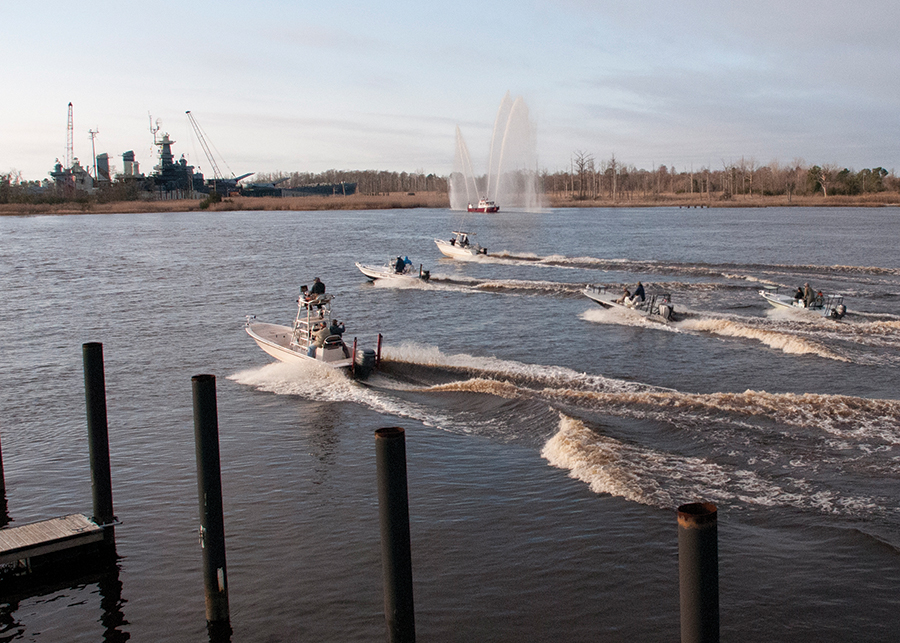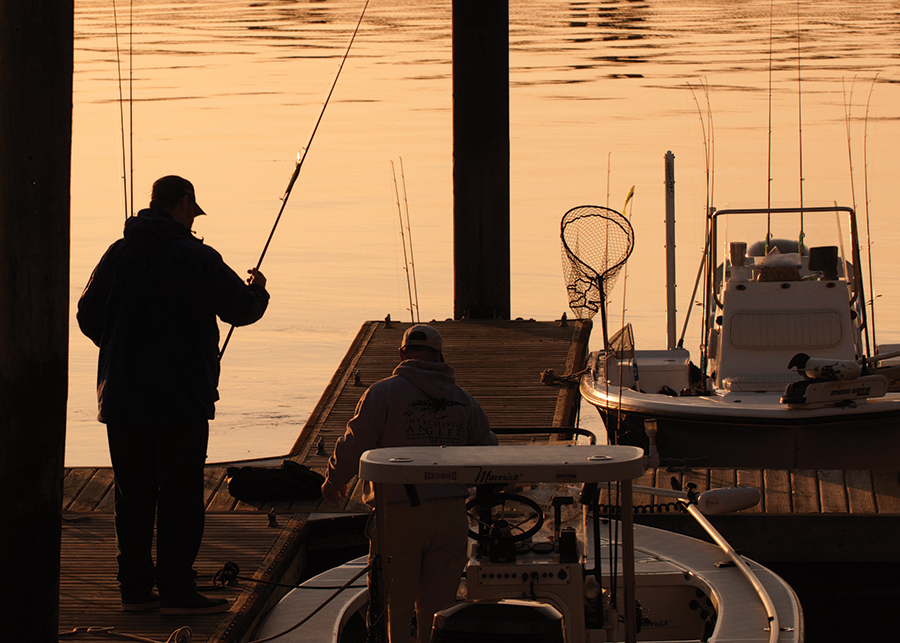A fair-weather fisher braves a day of winter fishing on the Cape Fear
By Virginia Holman • Photographs by Alan Cradick
I am a highly intermittent, fair-weather fisher. Don’t judge; there’s no shame in it. After all, in Wilmington, we can fish the waters for nearly three seasons a year wearing little more than a bathing suit, sunscreen and a life jacket. Life on the subtropical line makes a body spoiled. Once the winds switch north and howl down the long, empty fetch of the lower Cape Fear, it’s a labor to layer up for a long cold day on the water “just for fun.”
The past few winters, however, I’d seen increasing numbers of folks fishing in December and January. These weren’t commercial fishermen; these were average Jills and Joes on the water enjoying themselves. So last January, I broke down and decided to give cold-water fishing a go. Since I was a newbie, I decided to learn from one of the best, Capt. Allen Cain of Sightfish North Carolina, and joined the hale and hardy for the annual StriperFest Tag and Release Tournament.
Capt. Allen and other skilled fishing guides not only participate in this annual tournament, they also donate their fees to help fund studies of striped bass and other migratory fish in the Cape Fear River. Since 1915, when the first of three locks and dams were built on the river to ease riverboat navigation, anadromous fish like shad, sturgeon, river herring and striped bass have been unable swim to their native spawning grounds. These fish are unique: They live much of their life in saltwater, but swim upriver to freshwater habitats to breed. To striped bass, dams are simply walls that cannot be breached. As a result, our local population of stripers has declined at an alarming rate over the last century. According to Capt. Jot Owens, the founder of StriperFest Tournament, “The primary cause of striped bass declines in our area is the dams. Fortunately, efforts are underway to create a byway for these fish — and we’re a third of the way there. In 2012, the Army Corps of Engineers completed the first rock arch rapid, or fish passage, at Lock and Dam No. 1.” (Plans for passages at Locks and Dams Nos. 2 and 3 are in the works.) The fish passage is a large sloped terrace located just below the dam. Water collects in small pools within the terrace, and the fish are able to swim upriver from pool to pool. Eventually, they reach and surmount the dam.

After the first rock arch rapid was installed in 2012, a collective breath was held. How and when would we learn if the fish used the new passageway? That’s where the StriperFest Tag and Release Tournament comes into play.
Each tournament captain has a team of two on board. My teammate was Gary Hurley, the cheerful, mellow editor of the Fisherman’s Post. We arrived at sunrise at the Coastline Convention Center wearing about three days’ worth of clothing topped by a winter coat, sunglasses, and a face buff (the winter wind on the river is raw). Cape Fear River Watch does it up right for the StriperFest Tournament. Participants loaded up on pancakes and coffee, necessary fuel for the full day ahead, before heading to the dock. About five minutes before the starting bell, the Wilmington fireboat arrived and put on a majestic full-water salute: four plumes shot 30 feet into the air. Then Gary and I took our places on the boat, wished the other participants well (truth: we enjoyed some good-natured trash talk), and Capt. Allen opened the throttle to head to the first of several of his favorite honey holes.
The goal of the tournament is to catch as many stripers in a day as possible. Stripers of 24 inches and above receive sonic tags. These specialized tags require surgical implantation, so when someone reels in a big fish, the captain radios for the Division of Marine Fisheries patrol boat and a specialist onboard quickly implants the tag. When fish implanted with sonic tags pass by one of three riverside receiver stations, the data is recorded. (If you’re the gambling type, you can bid on a tag at the StriperFest Banquet auction. Then, you can participate in the annual Striped Bass Race to see which fish is the first over the dam.) For fish smaller than 24 inches, Capt. Allen inserted a P.I.T. tag (Passive Integrated Transponder) in the fish’s cheek, a quick 10-second procedure. The tag carries the same technology as the chips used for lost pets. Each chip has a unique alphanumeric code that researchers are then able to use tag scanners to track fish movements. Unlike the sonic tags, these P.I.T. tags don’t need batteries and cause less stress to the fish during implantation. A couple of nice stripers hit for Gary early in the day and I reeled in one that surprised me with its fight.

Throughout the day Capt. Allen and Gary coached me on my casting; before long my lure started to hit where I aimed. After a couple of hours in the main river channel, the cold wind was a bit much, so we wound our way up a long serpentine channel and fished the calm, ghost-forested waters of Smith Creek. The stripers seemed to hang out near the bridge pilings and along the river’s reedy edge. Staying out of the weeds and tree branches proved a bit challenging at times between the wind and the swift currents, but Capt. Allen’s relaxed and precise coaching kept me learning and improving happily over the course of the day. He’s a highly experienced and sought- after guide here and in Louisiana, where he runs winter fishing tours for redfish just outside New Orleans. He’s a natural: talented, focused and relaxed. After a long day on the water, we were all tired and a bit wind-burned and stiff from the chill. Even so, we remained in good spirits, a credit to Capt. Allen’s expertise with fish and people. At the end of the afternoon, our boat tallied six fish, a good haul on such a raw day. We headed back to the dock to fish the last remaining minutes up until the final buzzer. Though we came close, we didn’t land any stripers big enough for the sonic tags.
Back at the dock, no one rushed inside. The captains and competitors would soon tally the final numbers and the winners would be announced. After a full day of cold-water fishing, we were all looking forward to a warm drink and perhaps an award plaque or two. We lingered as the the sun set and the river was suffused in a golden light. We all knew the biggest prize was participating in such a glorious day of fishing for a such worthy cause.
StriperFest will take place Jan. 12 and 13, 2018. For information and tickets to the tag-and-release tournament and the banquet and silent auction, visit capefearriverfwatch.org. For Capt. Allen Cain, visit sightfishnc.com.
Virginia Holman writes about fishing and many other pursuits for Salt.


